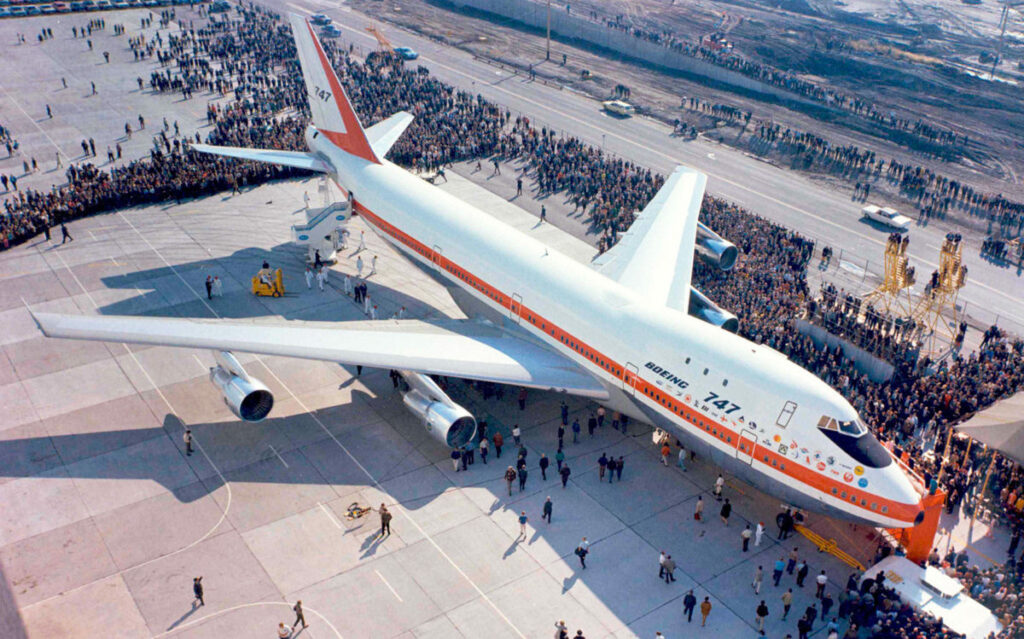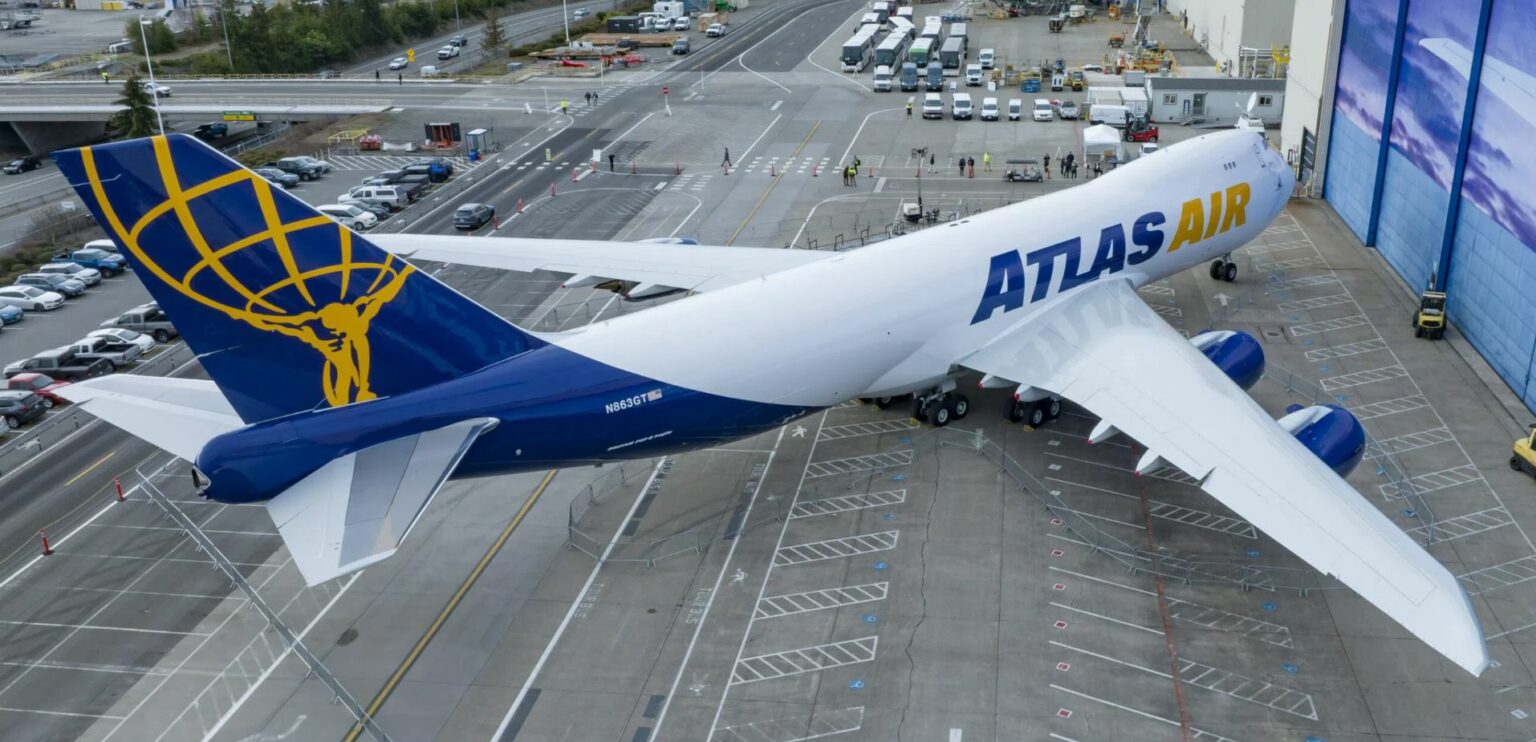Farewell, Queen: Boeing Delivers its Final 747
Legendary jumbo jet ends run after more than 50 years
By Evan Dougherty
Published February 6, 2023
Read Time: 4 mins
It’s the end of an era for one of the most iconic and beloved planes ever produced.
Boeing delivered its final 747 jumbo jet on Feb. 1 after a half century-long production run. Cargo carrier Atlas Air received the aircraft nicknamed “Queen of the Skies” in a ceremony attended by thousands, including Boeing employees who designed and built the aircraft throughout its production run.
“This monumental day is a testament to the generations of Boeing employees who brought to life the airplane that ‘shrank the world’ and revolutionized travel and air cargo as the first widebody,” said Boeing Commercial Airplanes President and CEO Stan Deal.
“It is fitting to deliver this final 747-8 Freighter to the largest operator of the 747, Atlas Air, where the ‘Queen’ will continue to inspire and empower innovation in air cargo.”
The jet, a 747-8 Freighter registered N863GT, departed from Boeing’s Everett, Washington, facility shortly after 8 a.m. local time for Cincinnati Northern Kentucky International Airport, where Atlas Air took delivery of the plane.
Along the way, the aircraft carved a monogram into the sky above Boeing’s home state of Washington and outlined “7-4-7” and a crown.
Well done to the @AtlasAirWW pilots! Now off to haul some cargo. https://t.co/4P132LZCvC pic.twitter.com/QIJuBT4gfH
— Flightradar24 (@flightradar24) February 1, 2023
The first widebody
The 747 was, ironically, born not as a passenger aircraft, but as a cargo hauler.
Boeing proposed the 747 in the early 1960s for a military contract to create a large transport plane. The 747’s design, featuring a nose door and its signature forward hump, would allow for easy loading and transport of outsized cargo.
Ultimately, the U.S. Air Force selected Lockheed’s C-5 Galaxy as the contract winner. But Boeing quickly saw another use for the 747, thanks to the booming demand for air travel.
Jets in passenger service at the time were single-aisle, narrowbody aircraft such as the Boeing 707 and Douglas DC-8. With demand increasing, airlines sought to add capacity, particularly on transcontinental flights.
Boeing modified the design of the 747 to optimize it for passenger service, and the first prototype took its maiden flight in 1969. A year later, the 747 entered revenue service for the first time with launch customer Pan Am—the airline most influential in the design of the aircraft—between New York and London.

The first Boeing 747 prototype was unveiled to the world on Sept. 30, 1968. (Image courtesy of Boeing)
As the first widebody aircraft to enter commercial service, the 747 quickly became a hit with airlines and travelers. Its lower trip costs and increased seating reduced fares and broadened the market for air travel.
The 747 was enjoyed for its wider, more spacious cabin, luxury amenities and its unique spiral staircase—a novelty on passenger aircraft—connecting the upper and lower decks.
Years after its service entry, Boeing evolved the 747’s design with major enhancements and upgrades. For example, the 747-400, introduced in 1989, included a stretched hump, winglets and newer engines for better efficiency.
The latest 747-8 variant, meanwhile, was introduced in 2005 with a fully redesigned cabin and stretched fuselage, making it the longest widebody aircraft in the world at 250 feet.
Special variants were made for highly specialized roles. NASA utilized two 747-100s to carry space shuttles back to Cape Canaveral, Florida, in between launches. It also flew its SOFIA 747-SP, retired in October 2022, which featured a giant telescope inside the plane’s fuselage used to gaze up at the stars.
Although it lost that long-ago contract o the C-5 Galaxy, the 747 still found roles within the U.S. military. The Air Force today flies four E-4B Nightwatch aircraft used as the National Airborne Emergency Command Post; they are equipped to survive a nuclear war.
In addition, the Air Force modified a 747-400, later designated as the YAL-1, with a giant laser to test shooting down incoming ballistic missiles.
And 747s have been synonymous with transporting heads of state, most notably the President of the United States, who flies on the VC-25A, otherwise famously known as Air Force One.
Not done yet
By the 1990s and 2000s, sales for the 747 dipped as cheaper and more efficient twin engine aircraft became available, such as Airbus’ A330 and Boeing’s 777.
In July 2020, Boeing announced it would end production of the 747 by 2022 due to a lack of new orders and the COVID-19 pandemic.
By then, most 747s were being phased out of passenger service due to age and newer twin jets being available on the market, with Delta Air Lines and United Airlines both retiring their 747-400s in 2017. The pandemic also accelerated retirements at other longstanding 747 operators in 2020, such as British Airways and Qantas.
While it may be past its prime for passenger service, some 747s still have lots of flying left.
German flag carrier Lufthansa is the largest operator of the latest 747-8 variant, with 19 in service, and plans to fly them for years to come. Korean Air also operates a fleet of 747-8s from Seoul to airports in the U.S., including Atlanta and New York-Kennedy.

UPS operates 39 total 747s in its fleet, including 28 of the new 747-8 Freighter variant. (Image courtesy of UPS)
The 747 also remains a popular aircraft for cargo carriers. Atlas Air (58 planes) and UPS (39) are large users of the 747, with many being newer 747-8 Freighters, according to Planespotters.net. National Airlines Cargo has recently acquired 747-400 Freighters for expansion of its network.
Additionally, two new Air Force One aircraft, which will be designated as VC-25Bs, are currently undergoing major modifications by Boeing in San Antonio, Texas. They will be delivered in 2026, replacing the current VC-25As that fly the U.S. president.
“The 747 is a symbol for many, many things, and above all, I think it’s a symbol for the world, which the 747 has made substantially smaller,” said Lufthansa CEO Carsten Spohr.
Watch
This Next
Read
This Next






